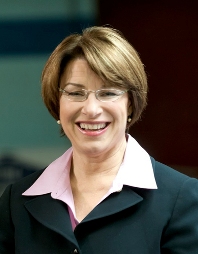Is Klobuchar’s Surge in Iowa a Big Deal?
Many White House hopefuls have reached double-digits in Iowa caucus polling during the 21st Century and ultimately floundered; few however mirrored Klobuchar’s timeline and trajectory

Performing well in the neighboring state of Iowa on February 3rd has been a crucial component to the Minnesota U.S. Senator’s campaign strategy who is not as well known nationwide as frontrunners Joe Biden, Bernie Sanders, and Elizabeth Warren or even upstart South Bend Mayor Pete Buttigieg.
While it is not clear if this single poll is the beginning of a bona fide, sustained surge in Iowa Democratic support for Klobuchar, it does generally conform with results of other recent surveys – that she sits atop the ‘second tier’ candidates in Iowa.
Klobuchar had previously received at least five percent support in each of the four public polls of Iowa Democrats released in November by Monmouth University, CBS News, Des Moines Register/CNN, and Iowa State University.
But will hitting this double-digit mark ultimately be a big deal, little deal, or no deal for Klobuchar with less than two months before the caucuses?
To be sure, in recent election cycles there have been many presidential candidates who at some point reached the 10 percent mark in an Iowa poll, but ultimately did not carry a single state in the subsequent primaries or caucuses:
- 2004 (Democrats): Joe Lieberman and Dick Gephardt
- 2008 (Republicans): Fred Thompson, Rand Paul, and Rudy Giuliani
- 2008 (Democrats): Tom Vilsack and Bill Richardson
- 2012 (Republicans): Herman Cain, Michele Bachmann, Rick Perry
- 2016 (Republicans): Carly Fiorina, Chris Christie, Mike Huckabee, Jeb Bush, Rand Paul, Ben Carson
In the 2020 cycle, Democrats Beto O’Rourke and Kamala Harris can be added to that list and each has already suspended their campaign.
One difference between Klobuchar and the more than a dozen names listed above, however, is she did not reach the 10 percent mark until much later in the campaign.
With recent cycles often finding voters (and perhaps the media) sampling candidates as a flavor-of-the-month, Klobuchar’s surge in the Hawkeye State – if genuine – is coming at a much more opportune moment than most of those names listed above.
For example, in 2004 Lieberman and Gephardt entered the race with double-digit support in Iowa. Lieberman last reached that level of support nearly a half-year before the caucuses in July 2003.
In the 2008 cycle, New Mexico Governor Bill Richardson first hit double-digits in a May 2007 Des Moines Register survey but only once reached that number over the few dozen surveys conducted over the last month of the campaign.
Former Iowa Governor Tom Vilsack – the first major Democratic candidate to enter the race – naturally polled high in his home state upon his entrance in the race, although he still consistently trailed Hilary Clinton, John Edwards, and at times Barack Obama before his February 2007 withdrawal.
Likewise, Guiliani and Thompson started with double-digit support in their party upon their entrances in the race in April and September 2007 respectively as did Bachmann and Perry during the 2012 cycle.
In the 2016 cycle, Fiorina last saw 10 percent in polling among Iowa Republicans in September 2015 with Bush doing so in August 2015, Huckabee and Paul in June 2015, and Christie in August 2014 well before he jumped into the race.
Ben Carson did still occasionally hit the 10 percent mark in December 2015 and January 2016, but his numbers had cratered from his peak popularity among the Iowa GOP from a few months prior in October.
And so, on the plus side, Klobuchar appears to be ascending in Iowa at a much later (and more strategic) point in the cycle than those candidates mentioned above.
On the other hand, the Minnesotan is still looking up at four candidates in the polls and there is still plenty of time for her candidacy to be scrutinized and critiqued by her rivals which could blunt her forward progress.
Follow Smart Politics on Twitter.
